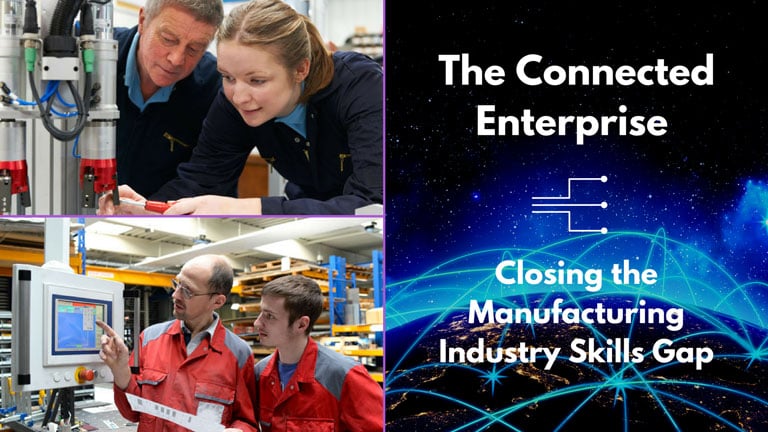This article was written by Beth Parkinson, director of market development for the Rockwell Automation connected enterprise initiative.
The global manufacturing and industrial workforce is in the midst of monumental change. Nearly 3.5 million U.S. manufacturing jobs will likely need to be filled by 2025, projected a Deloitte report on the skills gap issue. Yet 2 million of those jobs are expected to remain unfilled due to an existing skills gap. Canada is expected to be short 114,000 workers needed to help the country reach its projected capacity of 3 million barrels of oil-sands production per day in 2021.
In China, the over-65 population is expected to reach 210 million by 2030 and account for one-fourth of the population by 2050, according to The Wall Street Journal. This is occurring as wages rise and the number of college graduates increases, resulting in more Chinese factories struggling to fill positions.

The E.U. employment rate for people aged 55 to 64 is below 50 percent—significantly lower than the overall employment rate of about 70 percent for people aged 20 to 64. In contrast, 37 percent of employers in Latin America are having trouble filling positions due to a lack of available talent, higher than the global average, according to the Manpower Group.
These changes threaten to significantly reduce economic growth, barring a considerable acceleration in productivity. They affect the safety of both older and younger workers. The availability of skilled workers is shrinking globally, so methods such as offshoring and workforce mobility are less effective. Instead, companies need to address the issue by increasing both productivity and safety where they operate today.
Fortunately, a more impactful transformation is occurring in parallel: the convergence of information technology and operations technology systems into a connected enterprise. This convergence raises questions of how to reshape workforces and creates ways to use advanced technology to meet demand.
The connected enterprise is the linking of information from sensors and machinery on the plant floor, up to the enterprise, and across the entire supply chain. Seamless information sharing spans people, processes, and technologies across global and remote operations, enabling better collaboration, faster problem solving, and improved innovation and productivity.
Gateway to greater productivity
The connected enterprise offers a number of opportunities to address or offset the productivity challenges of the evolving workforce. For example, the ability to deliver worker-specific instructions reduces complexity for inexperienced workers. Information collected from experienced employees and integrated into workflow instructions helps preserve critical tribal knowledge. Conversely, the ability to track and record processes helps technicians identify problems more quickly and pass that information to operators.
Information delivered on mobile devices helps younger workers track critical processes using familiar technology and delivers information to older workers on the plant floor with “anytime, anywhere” convenience, reducing physical demands. Remote-access technology reduces the need for workers to sustain multiple sites spread across large areas. For example, oil and gas operators use remote-monitoring technology to supervise wells, saving travel time to check remote wellheads, pump stations, and storage sites.
Safety in the connected enterprise
A connected enterprise helps workers identify risks and gain new insights into where safety-related shutdowns and incidents are taking place. Information collection and analysis can expose the particular locations, applications, and operations where risks are higher.
This insight goes well beyond the simple identification of where injuries are currently happening in a single plant. It includes identifying common applications across an enterprise with injuries, near misses, and safety shutdowns that affect both worker safety and productivity. Once problems are identified, companies can implement solutions to reduce safety incidents or improve productivity (e.g., analyzing lock-out/tag-out locations to see if there are opportunities for alternative measures to improve productivity).
Balanced approach
The connected enterprise offers an approach to meet the workforce needs of tomorrow, but it is likely only part of the solution for most manufacturers and industrial operators. A complete commitment to addressing looming workforce challenges also requires other approaches: engaging in local communities to attract and improve the skillset of younger workers, improving machinery design to address the ergonomic needs of older workers and the safety of younger workers, refocusing workforce training to manage knowledge transfer and improve worker competency, and leveraging external services for less frequently required skills and for positions that are not easily filled.
About the Author Beth Parkinson is director of market development for the Rockwell Automation connected enterprise initiative. Parkinson joined Rockwell Automation in 2002 and has held various positions in market development and strategic alliances. Previously, she worked at companies focused on business software and Internet solutions, including Autodesk, Baan Company, 2Bridge, and Citadon. Parkinson earned a BS in public and environment affairs from Indiana University in Bloomington, Ind.
Beth Parkinson is director of market development for the Rockwell Automation connected enterprise initiative. Parkinson joined Rockwell Automation in 2002 and has held various positions in market development and strategic alliances. Previously, she worked at companies focused on business software and Internet solutions, including Autodesk, Baan Company, 2Bridge, and Citadon. Parkinson earned a BS in public and environment affairs from Indiana University in Bloomington, Ind.
Connect with Beth:![]()
![]()
A version of this article also was published at InTech magazine.



